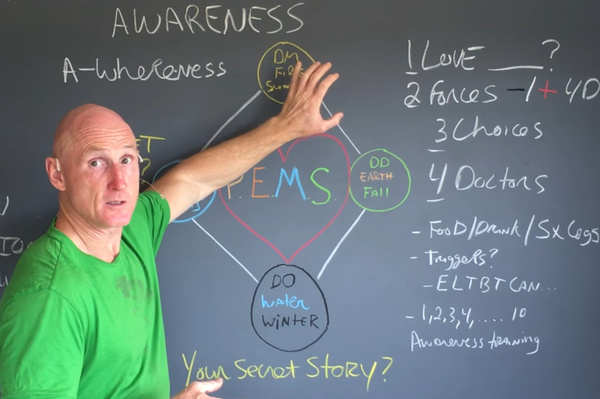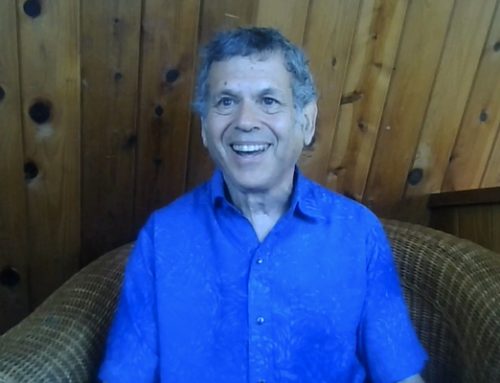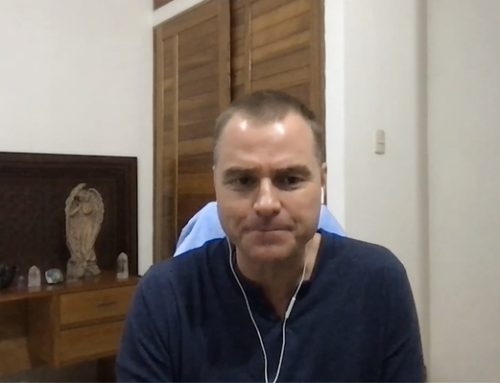Happy Monday! Life has a habit of getting in the way of busy people, especially when time is in short supply and things need to get done. For me lately, that’s been teaching classes, doing speaking engagements, working with clients and developing the CHEK Academy and why we had a short detour away from my newest blog series last week!
But now, we’re back on track with part 2 of the Seven A’s of Healing based on Dr. Gabor Mate’s awesome book, When The Body Says No: Understanding The Stress-Disease Connection, which is all about awareness.

In part 1 of this series, we learned how important it is to accept the need to heal in order to do the work it takes to be healthy and whole.
Awareness is very, very important too because without it, you’re unaware or unconscious. In fact, you could say that awareness is equivalent to being conscious of something.
Often, the act of being unaware — by repressing or suppressing things so you don’t have to deal with them — can become so habitual you don’t even realize that you’re doing it.
That doesn’t mean those issues underneath the surface aren’t affecting you physically, emotionally and mentally.
Generally, people stuff down the things that have the most pain or fear attached to them. They’re the most charged, meaning they have strong associations with everything in your environment involved in that initial experience.
Over time, those repressed experiences and their associations begin to link up with everything and everyone in your environment. They become what’s referred to in Jungian psychology as a complex set of emotionally charged associations that can literally develop an artificial intelligence — even a personality — all their own.
For example, you may behave very uniquely in the presence of your mother, father and siblings, but in very different ways around certain friends, your lover or a boss. What that’s telling you: there are neural networks regulating the persona, the expression of yourself and the masks you wear based on whatever you have a conscious or unconscious fear of in that environment or with that person.
Unfortunately, a lot of these complexes develop in our first 14 years of life while we are under the submission of our influences, which can range from parents and teachers to caregivers and social influencers.
Healing can be very difficult, particularly for people who have not developed their own ego, a sense of individuality and a willingness to say yes to things that are congruent with their own dream and no to things that aren’t.
Until that development happens, people often feel all sorts of repressed thoughts, emotions, resentments, anger and biases based on the stories living in their heads that remind them why their problems stem from “what that person did or took from me.”
These kinds of reactions are giving your power away to somebody else and blocking every opportunity for you to heal and grow.

A-whereness
To give you some clarity, think of awareness as a-whereness, a sense of where you are right now.
When you’re in a deep dreamless sleep, you’re nowhere and you’re everywhere. You don’t even know you’re alive. You can feel and react the very same ways in the waking world.
Just imagine driving down the road listening to the radio and missing the last couple of minutes, only to realize you may have driven through a red light. That’s an example of not being aware of being somewhere else while you’re doing something else, and a great way to get injured or add unnecessary stress to your life.
Within spiritual development, there’s many ways to teach or develop awareness. An example is doing a fire walk like ones you’ve probably seen in Tony Robbins seminars. I did that fire walk too, many years ago.
When you do it, you have to be completely and utterly aware or you will get burned if you lose your sense of awareness for even one second. When you’re walking on 2,600-degree coals, you must shift your energetic state and expose yourself to the heat of those coals.
Again, awareness means being a-where… where am I and what’s happening to me.
You’d be amazed by how many people face legitimate crises that require healing, like a disease, failing relationship or financial catastrophe, because they are not present within themselves.
Sometimes, this is due to trauma that’s not healed yet. When people face real and threatening traumatic situations, particularly when they’re too young to know how to handle them — dealing with an alcoholic or an abusive parent or physically violent situations — the soul or consciousness can literally jump out of the body.
Without what Native American Indian healers or energy healers call soul recovery, that part of us becomes inaccessible to our conscious mind until we’ve done integration work and healing.
That’s why people need professional help to recover their consciousness. This allows people to come face-to-face with the event in a safe or sacred environment where they can feel safe to engage their explicit memory of the events or their implicit memory.
What does that mean? Often, we don’t have an explicit memory of what happened. Because we feel that something’s wrong and know something happened at a deep level, we have to work with our emotions and our body’s messages, which is our implicit memory of them.
Going deeper
Going forward in my vlog, I discuss a very simple model that I teach in all of my books, courses and workshops related to the 4 Doctors which is the bedrock of my whole living philosophies.
When you’re in a process of healing and wanting to apply the Seven A’s, the first thing you must do is get clear about what you love enough to heal for.
If you don’t have a sense of direction, you probably don’t really have any motivation or inspiration to do the things you need to do, or make the changes you need to make.

As Lewis Carroll once said, “If you don’t know where you’re going, any road will get you there.” Identifying what you love enough to focus on as a dream, goal or objective is critical so you have enough of a commitment to really participate in your own healing.
If you can’t recognize that one thing you love enough, it may be easier for you to identify the nightmare blocking your way. Simply put, it’s the one obstacle in your life that, if you dealt with and addressed it honestly, would free up the most energy and potentially the most resources so you could begin to get clearer about what your dream or love is.
Plus, this decreases your stress levels enough so that you’re not in pure survival mode, and your creativity, natural problem-solving abilities, openness and willingness can begin to engage in productive, dream-affirmative ways.
If you want to take that next step toward awareness, we go much deeper into this in my Holistic Lifestyle Coaching program, specifically HLC 2 where we assess these issues over the course of five days.
However, if you want to get started right away, you’ll want to read my multimedia ebook, The Last 4 Doctors You’ll Ever Need. It contains videos, slideshows and audio tracks that help you do simple things, like using a Tibetan bowl or tuning fork to bring the chaotic energy in your body into better harmony with your body, mind and emotions. That simple tool promotes better awareness right away.
Also, How to Eat, Move and Be Healthy! includes a series of questionnaires that give you feedback about the level of stress in key body systems, and ways to bring your score down through zone exercises, better breathing, simple movements and conscious awareness of the energies flowing through you.
All of this information you learn through these questionnaires will help you figure out where you’re stuck and start focusing on healing those problem areas.
Next time, I’ll talk to you about anger — for better or worse — when it comes to healing in part 3 of my series.
Love and chi,
Paul

Resources
When The Body Says No: Exploring The Stress-Disease Connection by Dr. Gabor Mate
Courses on mindfulness by Dr. Jon Kabat-Zinn
Arnold Patent’s Universal Principles
The work of the Christian Contemplatives
The works of Rudolf Steiner





